This will be the best Japanese tonkotsu ramen and the only recipe you will ever need. Nothing can compare with this homemade authentic ramen broth: super creamy, rich, tasty, and made 100% from pork bones and Japanese ingredients.
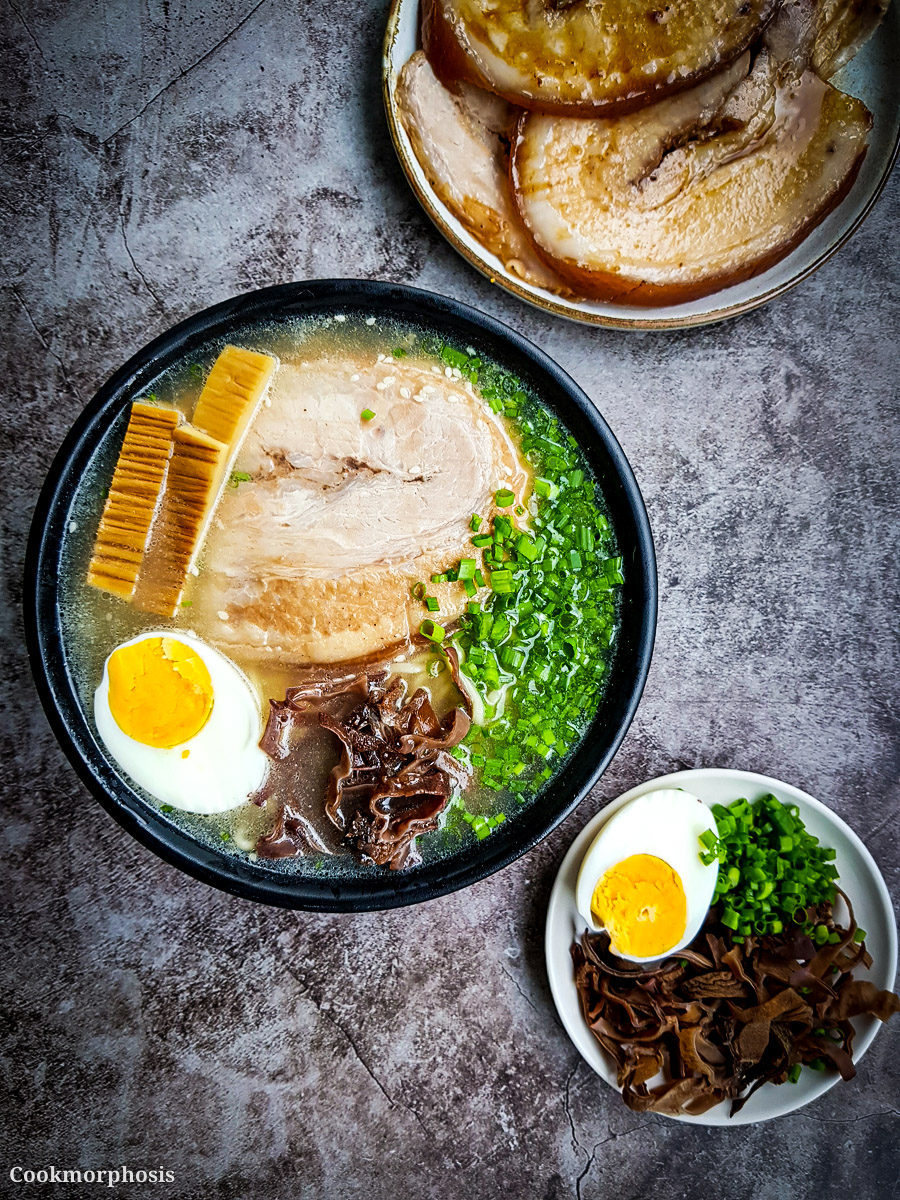
This is a complete and throughout guide for anybody interested in making the best Japanese tonkotsu ramen from scratch. Falling in love with restaurant style ramen and always wonder how it was made?
Well, congratulations! You're at the right place. Also, keep reading to see the behind the scene photo, you'll see how madness my kitchen counter was.
This recipe probably is the longest and most detailed non-baked recipe available on my site up until this point.
Want to know the second longest recipe is? Check out this one of a kind Hong Kong style Soya Sauce Chicken.
Since you're here, maybe you have a curious love for ramen, even the instant type. Suppose you haven't tried one but have been falling in love with restaurant-style ramen and want to make a quick bowl at home. It would help if you tried packed ramen like this famous Buldak ramen. You'll get a delicious hot bowl in just a blink.
What is tonkotsu ramen?
Tonkotsu in Japanese means pork bones. Tonkotsu ramen means pork bones soup ramen. That said, the main ingredient of this recipe is pork bones with an extra of pork fat.
Here are the break down of this Japanese ramen recipe:
- Ramen noodle - can be fresh, frozen or dry.
- The homemade authentic ramen broth includes two parts:
- Ramen sauce: used to control and adjust the saltiness of a ramen based on personal reference.
- Ramen stock: used to mix with ramen sauce to create such creamy, milky and super rich texture and flavor for the soup
- Chasu - main topping of this ramen is made from sweet and sticky pork belly.
- Other optional toppings for Japanese tonkotsu ramen:
- Menma - seasoned bamboo shoot (recipe included)
- Namuru - spicy seasoned beansprout (recipe included)
- Ajitstuke Tamago - soft boiled ramen eggs
- Wood ear fungus
- Green onion
- Toasted white sesame seed
- Ichimi togarashi - Japanese chili pepper powder
- Dried seaweed

Steps to make Japanese tonkotsu ramen
The homemade authentic ramen broth includes: ramen sauce and ramen stock.
Ramen sauce is what we use to control the level of saltiness of the soup in general. While ramen stock is the creamy and rich liquid we see mostly in any ramen.
Ever wondered why we always see the salty option on the order sheet at every ramen restaurant and how they do it? Well it is because of the ramen sauce.
Ramen sauce
Ingredients include in this ramen sauce:

- Mussels - you can use either frozen or fresh. This is how tonkotsu ramen get its umami flavor from.
- Usukuchi shoyu - this is not your typical soy sauce. It is a light body soy sauce which mainly used for seasoning rather than dipping. Usukuchi shoyu has a complex umami flavor.
- It is best to have the right Japanese version of this shoyu. You can find it here.
- However, if it is impossible to find one in your area, light soy sauce is the closest substitution. But keep in mind, the taste of the ramen won't achieve the best umami it's supposed to be.
- Koikuchi shoyu - regular version of Japanese soy sauce. You can easily find this in any Asian market or of course, Amazon.
- Fish sauce - I always love and trust Red Boat fish sauce.
- Sweet mirin - my most favorite Japanese ingredient and always have it in my pantry. You can find it here.
- Other recipes using sweet mirin:
- Cooking sake - if you can't find cooking sake, you can use Chinese cooking wine or vodka in replacement.
- Apple cider vinegar
- Honey
- Kombu - kombu is an edible kelp that is totally different from dried seaweed (used for rolling sushi or kimbap).
- White miso - either this or sake kasu. Together with mussels and kombu, it helps to create a complex flavor for the ramen.
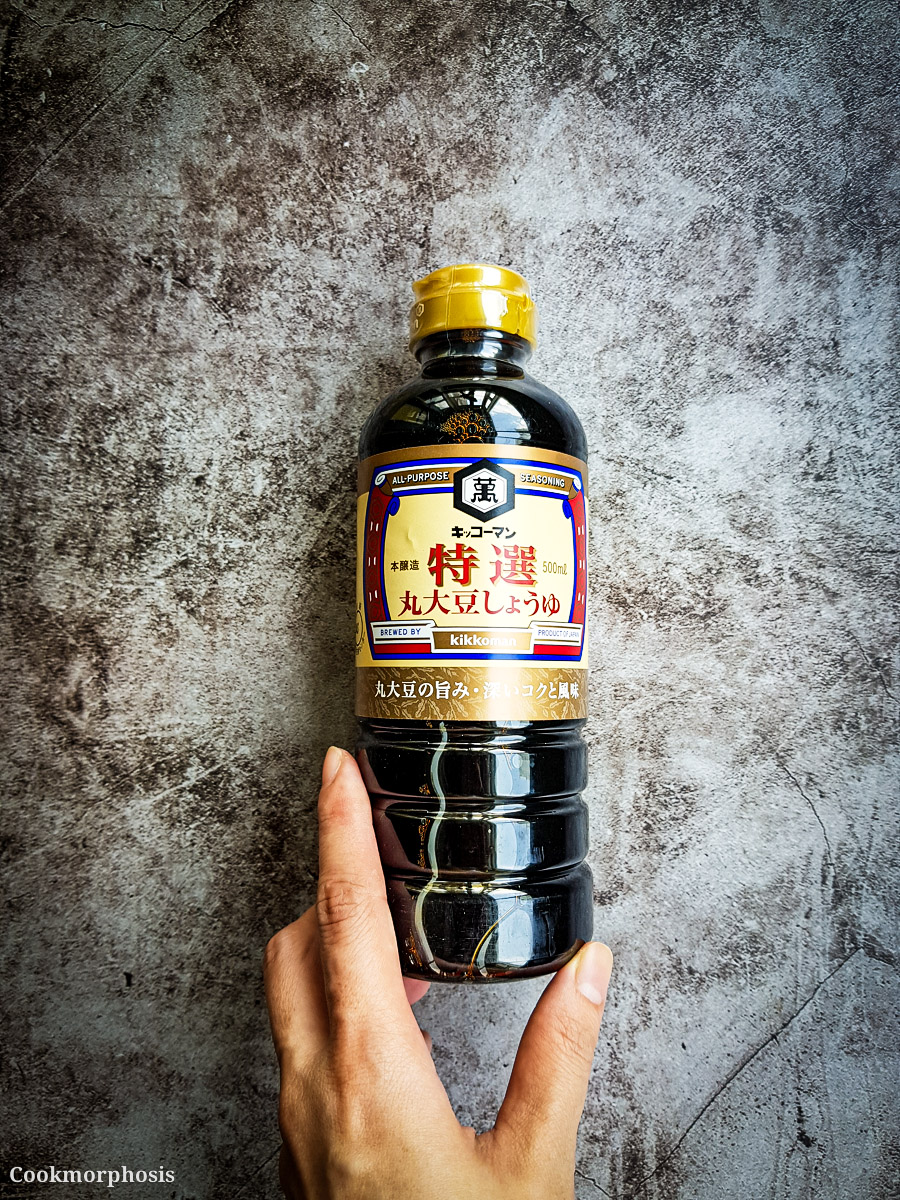
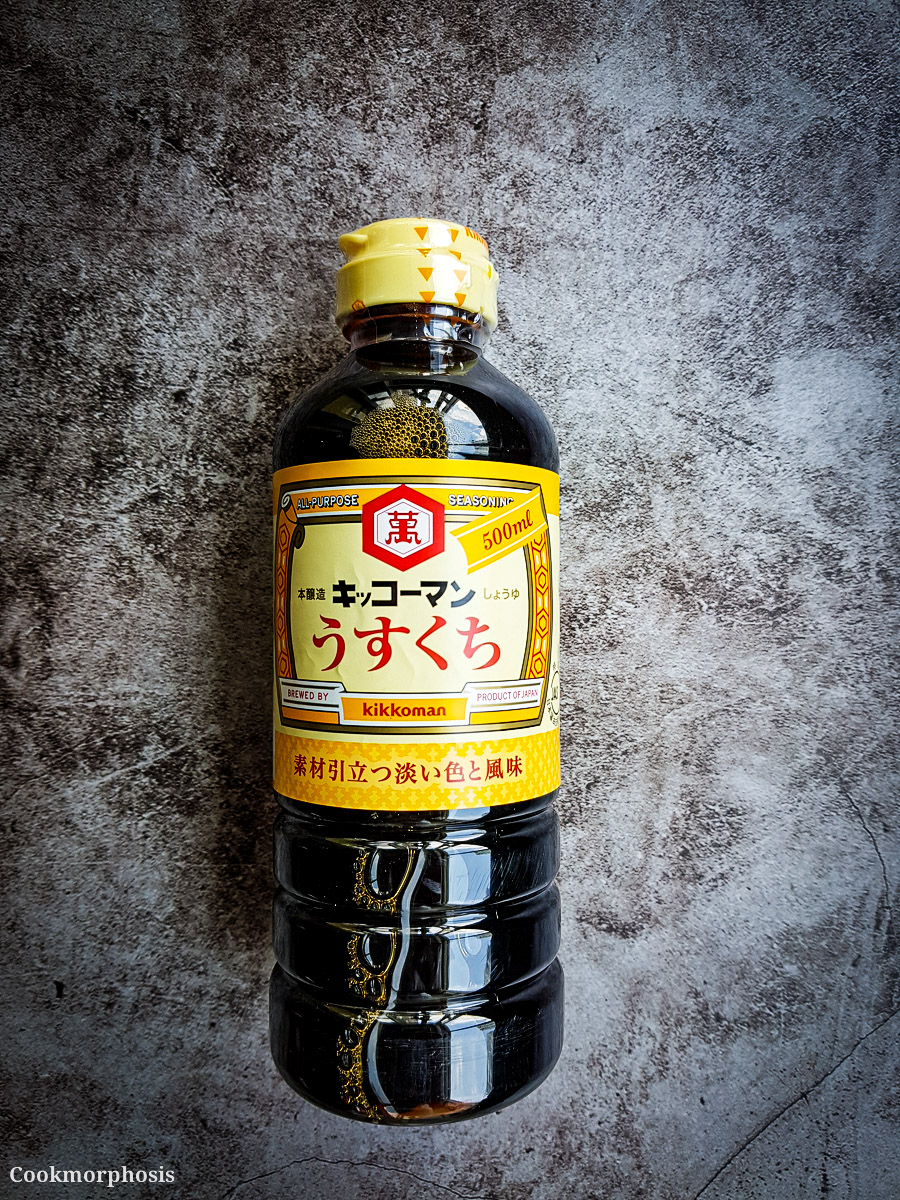
How to make ramen sauce (approximately 30 to 40 minutes)
- Boiling water with mussels, reduce the liquid by half then strain through a fine sieve mesh.
- Add the rest of the ingredients (except miso). Bring to boil again then reduce the heat to simmer.
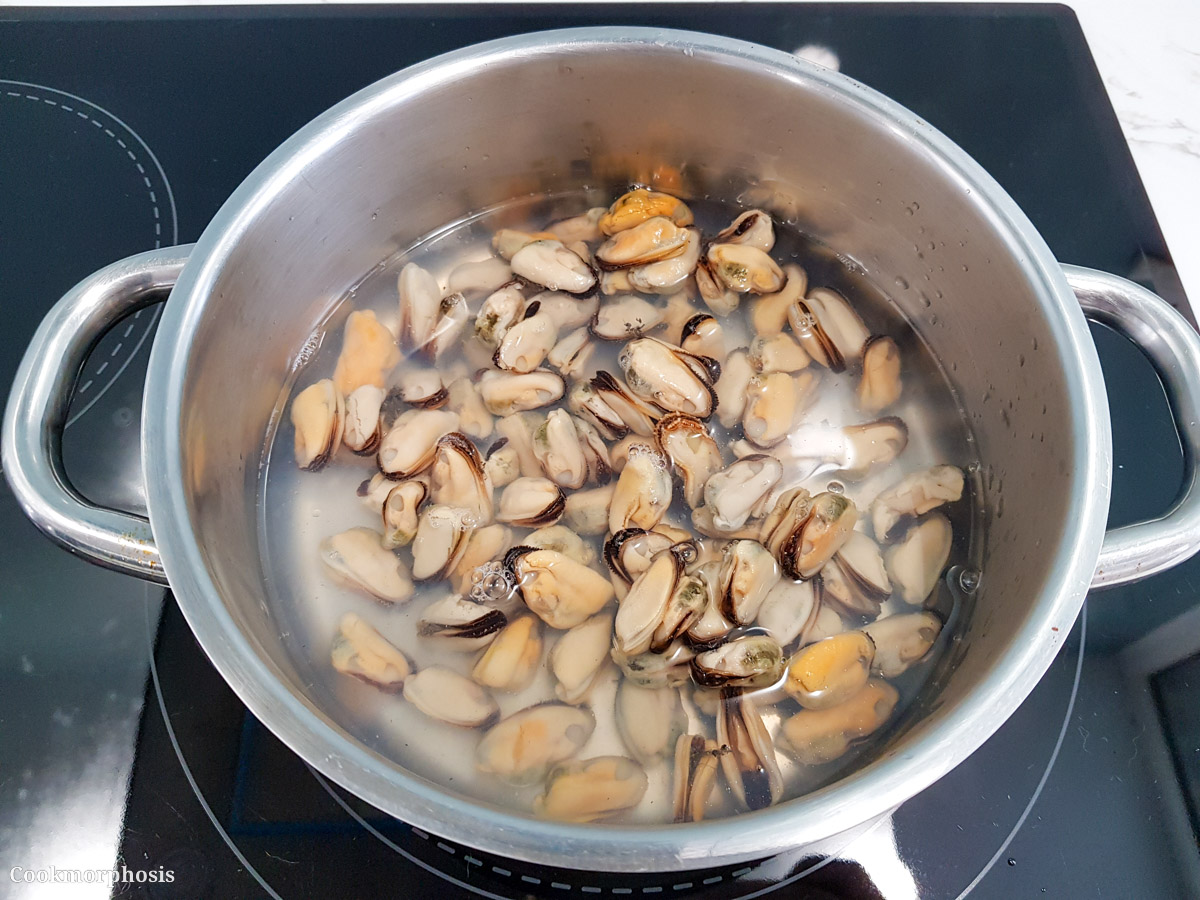
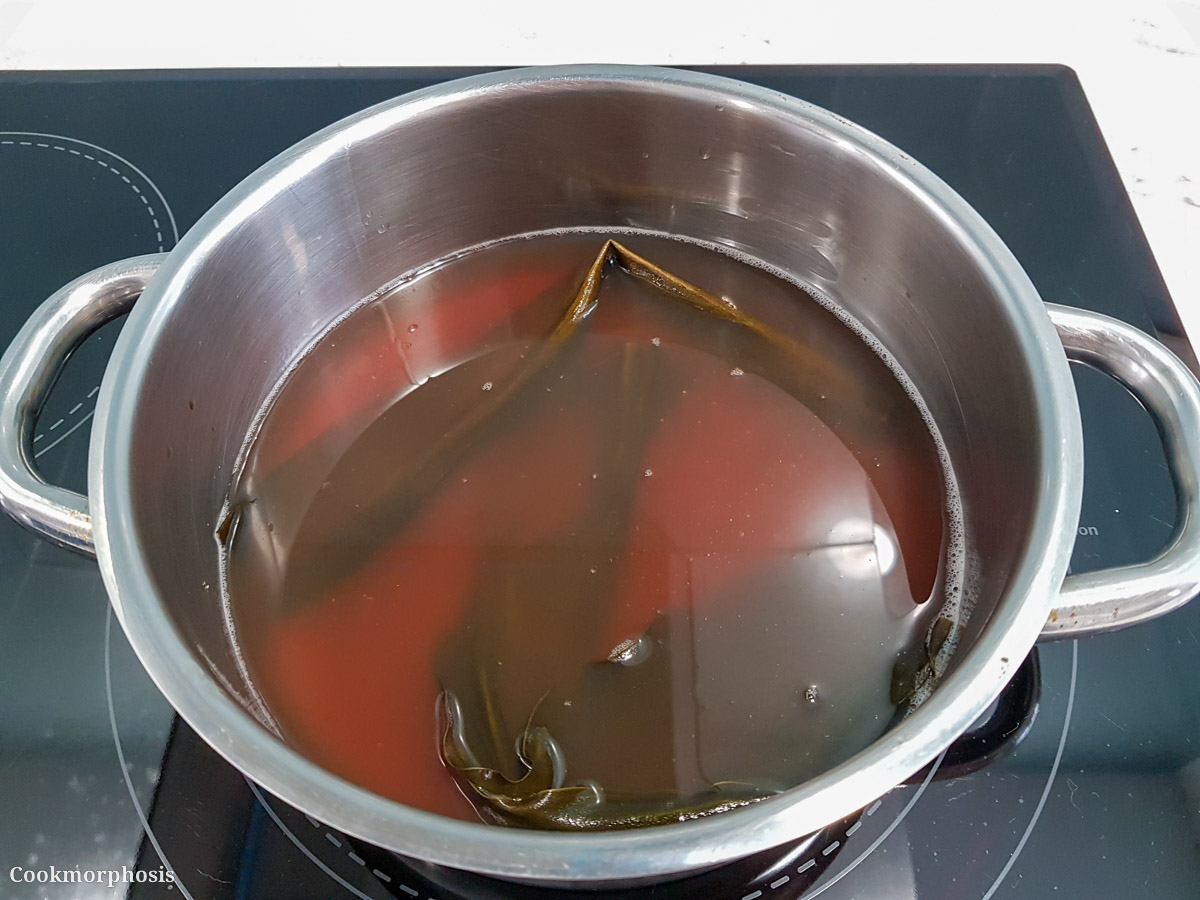
- Then add miso and cook until it dissolves completely.
- The ramen sauce is supposed to be salty than regular taste because it is used to season and adjust salty level of Japanese tonkotsu ramen.
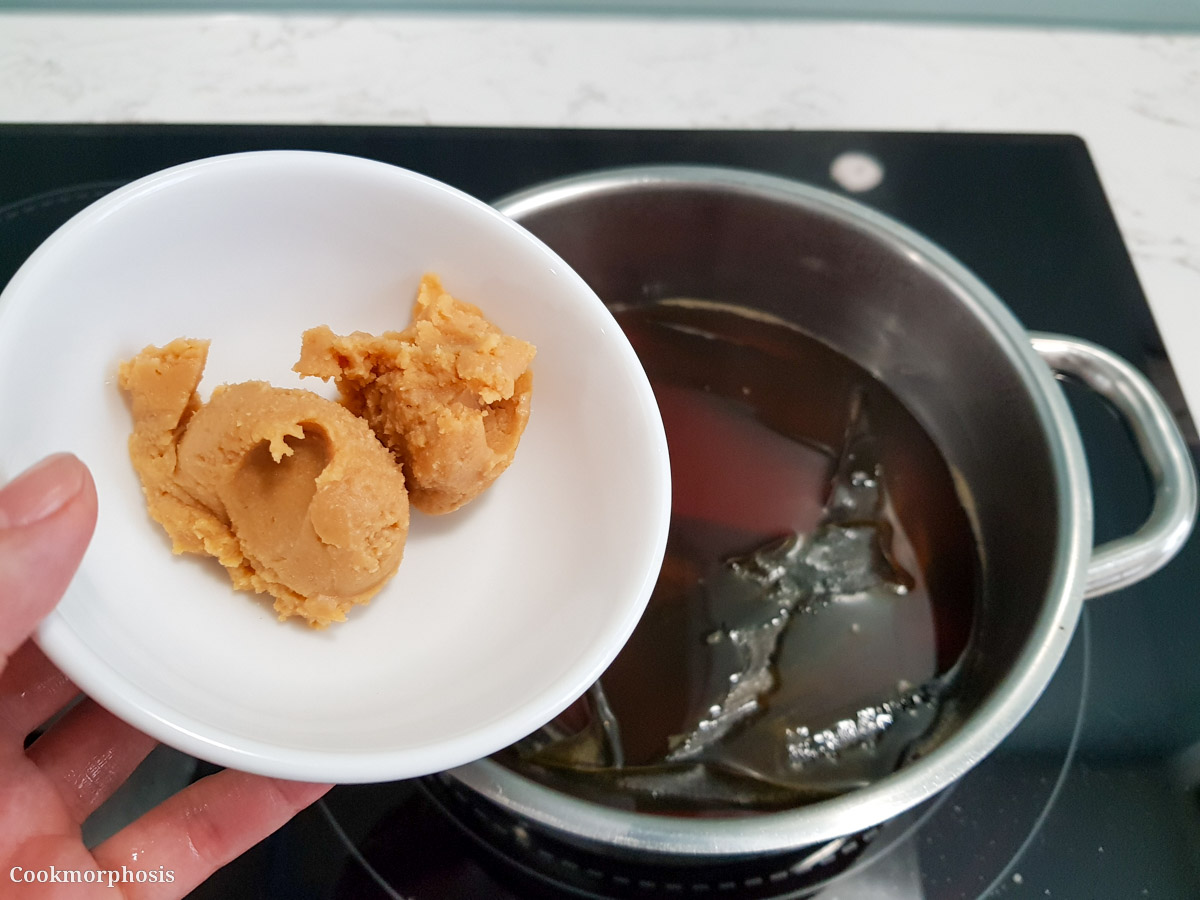
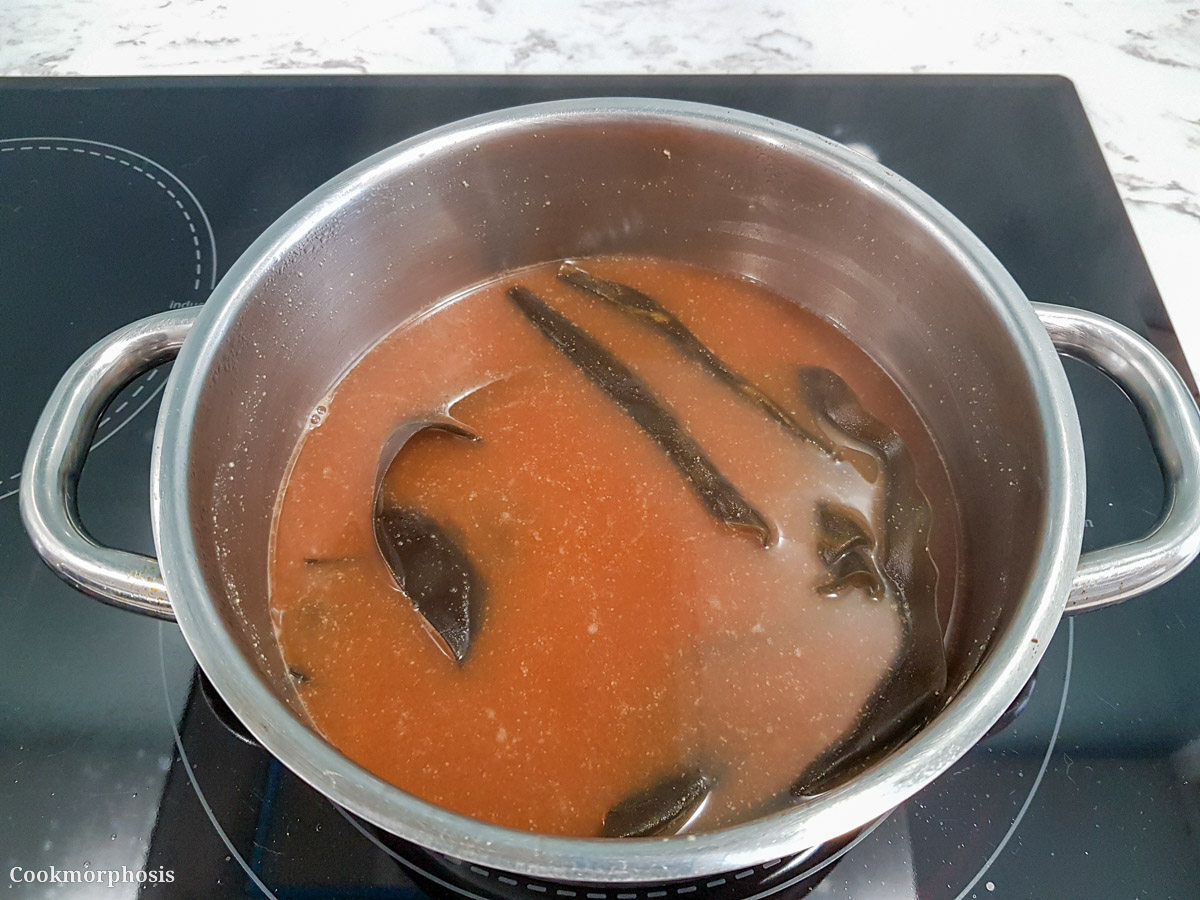
Ramen stock
Ingredients include in the stock:
- Pork bones
- Pork fat
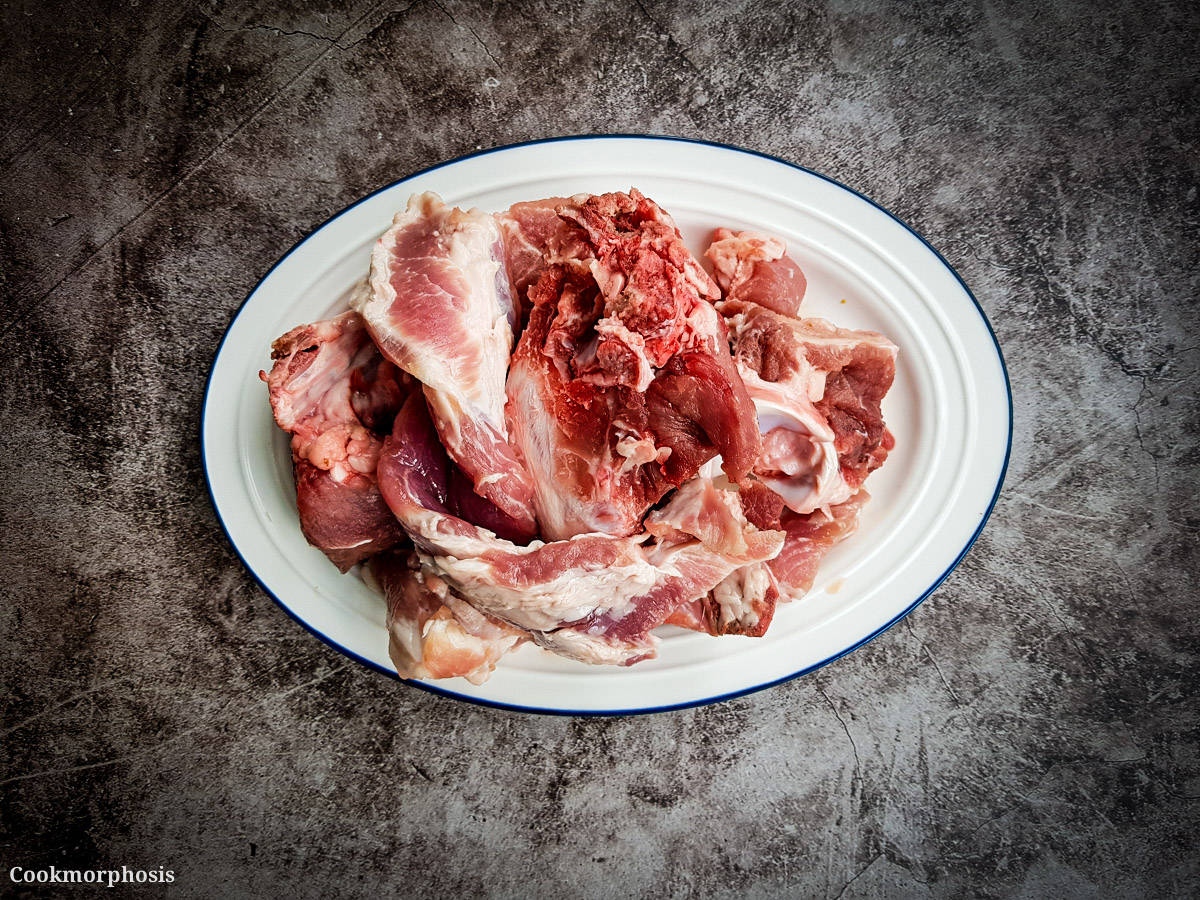
How to make ramen stock (estimating time: at least 4 hours)
- Add pork bone into a large stocking pot and enough water to submerge them completely.
- Bring to boil then simmer the pot for at least an hour. Skin any impurity that is floating to the surface.
- After an hour, take out about 90% of the stock and set aside for later use.
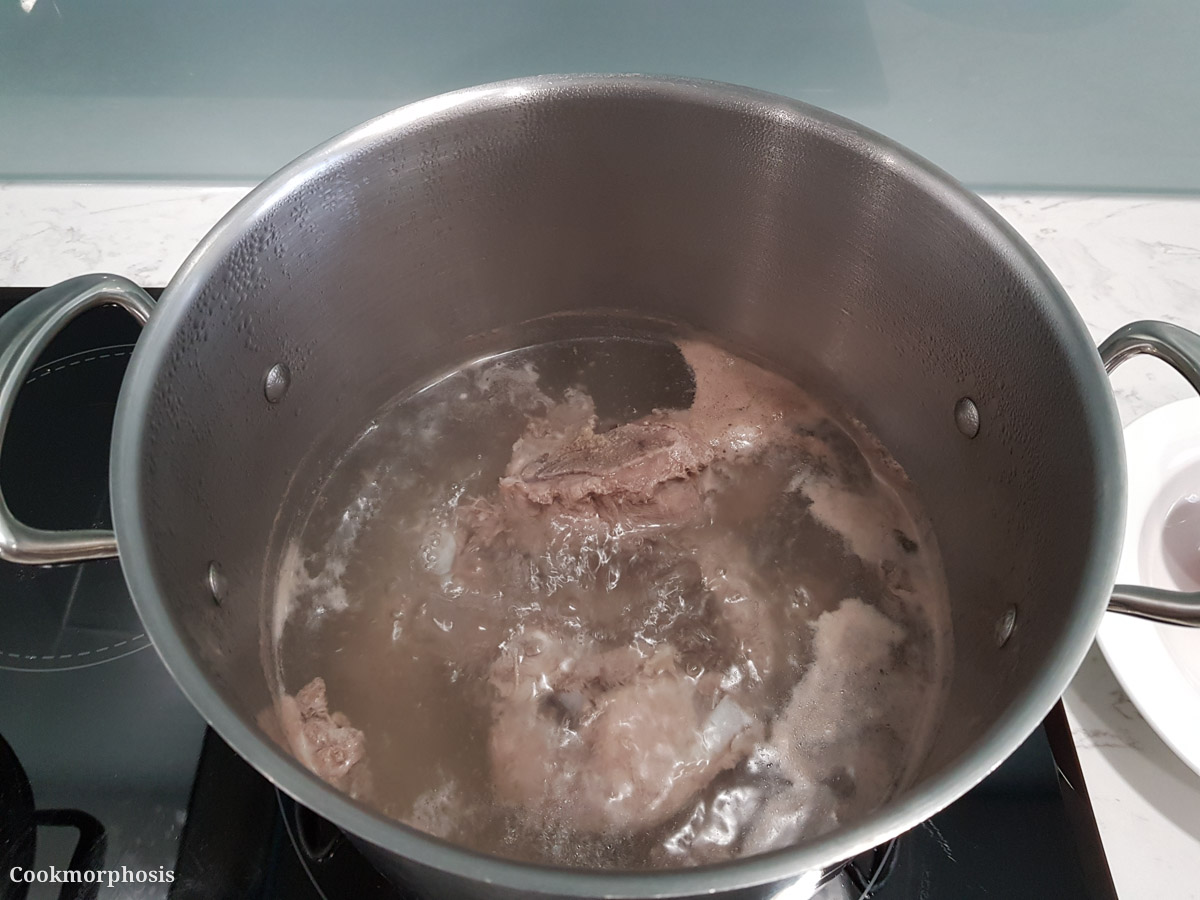
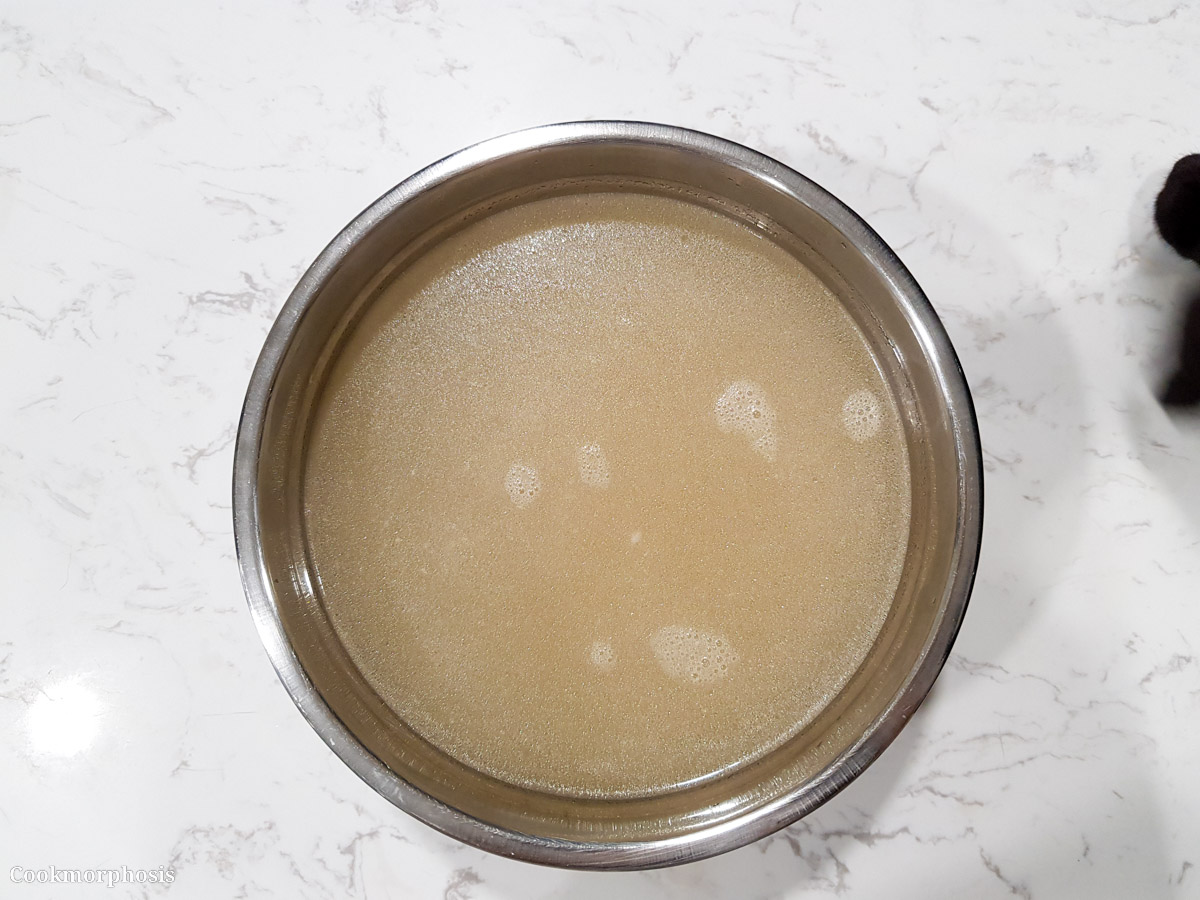
- Then add pork fat and enough water to submerge everything completely, bring to boil again.
- Keep the pot boiling hard at all time on medium high heat to create such milky and cream texture for the soup.
- Cook the mixture for 2 hours.
- During the process, when the water reduces and no longer cover pork bones and fat, add more water immediately. Approximately 30 to 40 minutes between every cycle.
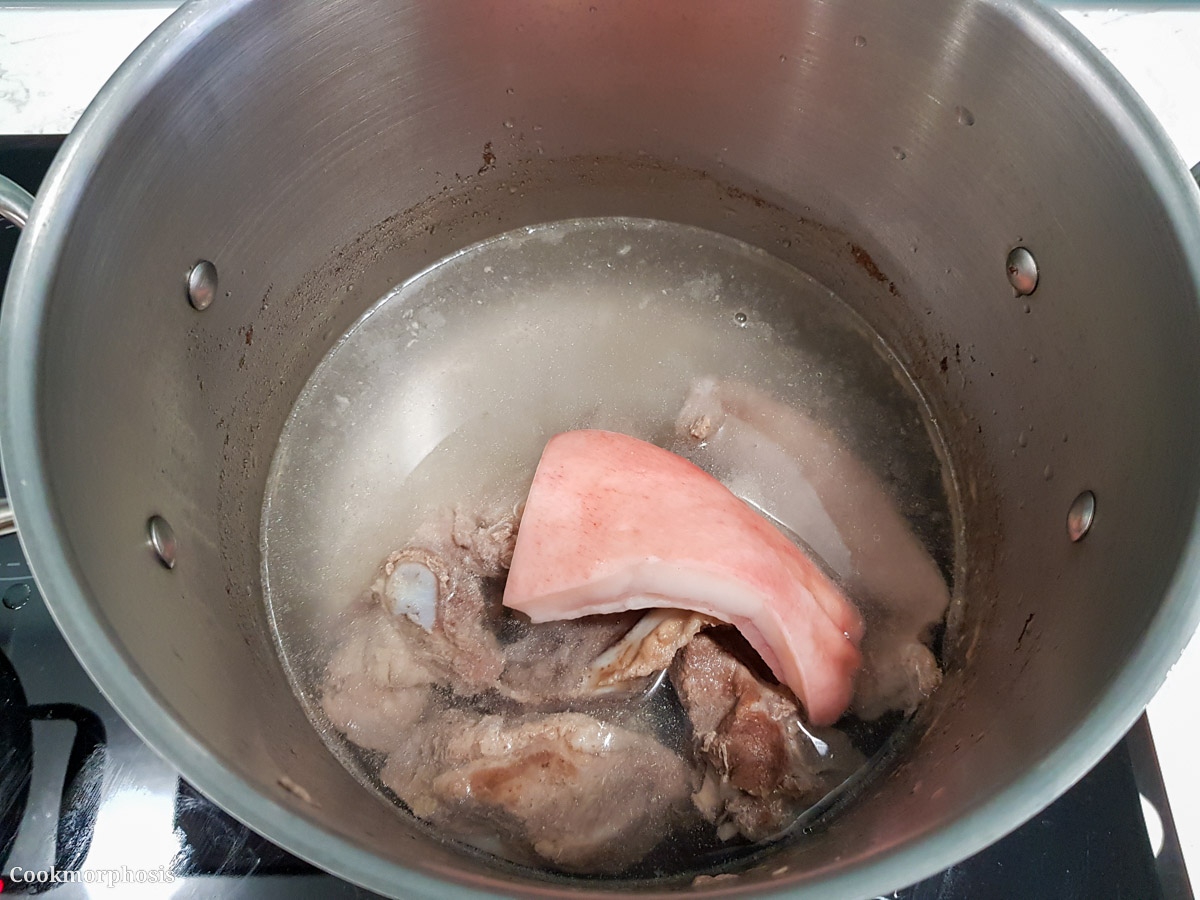
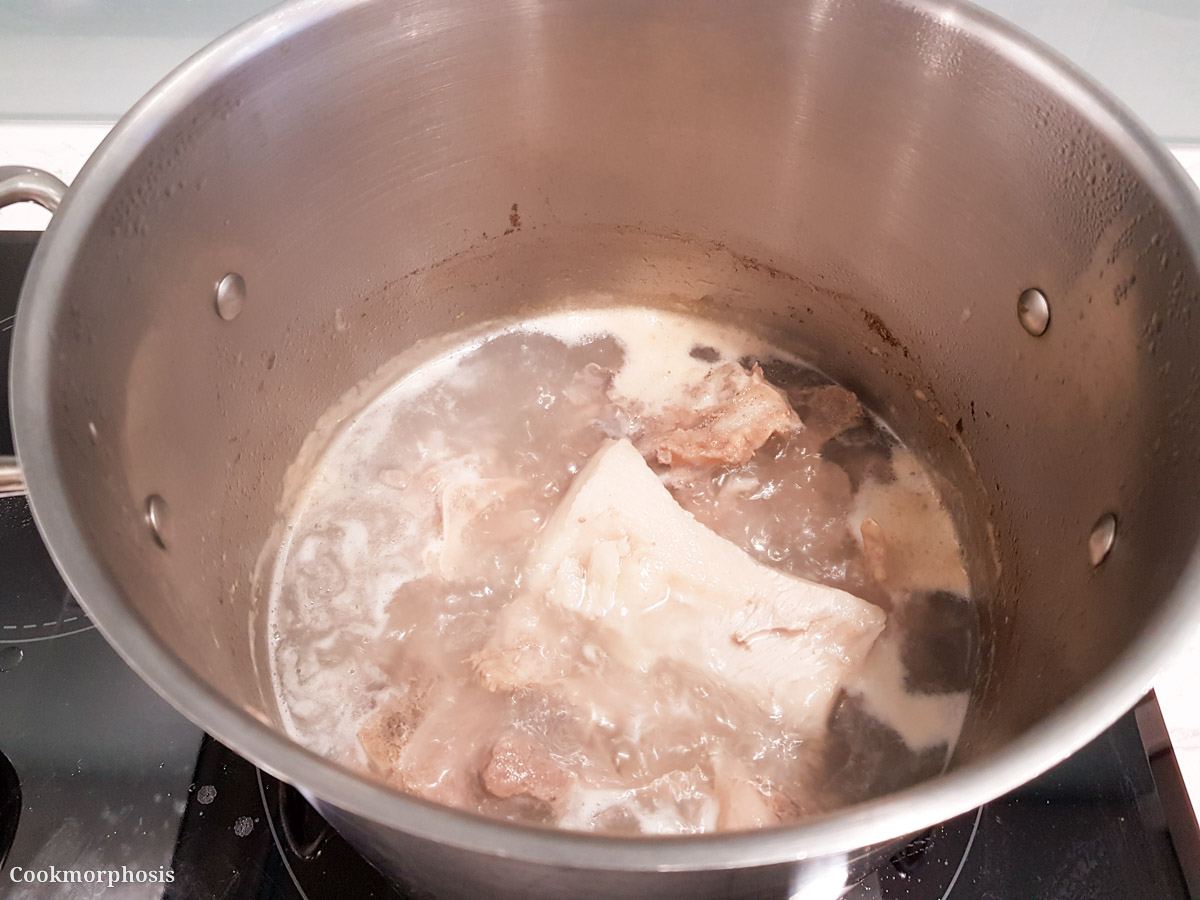
- After 2 hours has passed, continue cooking the stock for at least an hour. But this time, instead of adding fresh water to the pot, using 90% of stock was set aside to add to the pot.
- Repeat the process of adding more water when it is reduced below the bones. Approximately 20 to 30 minutes between each cycle.
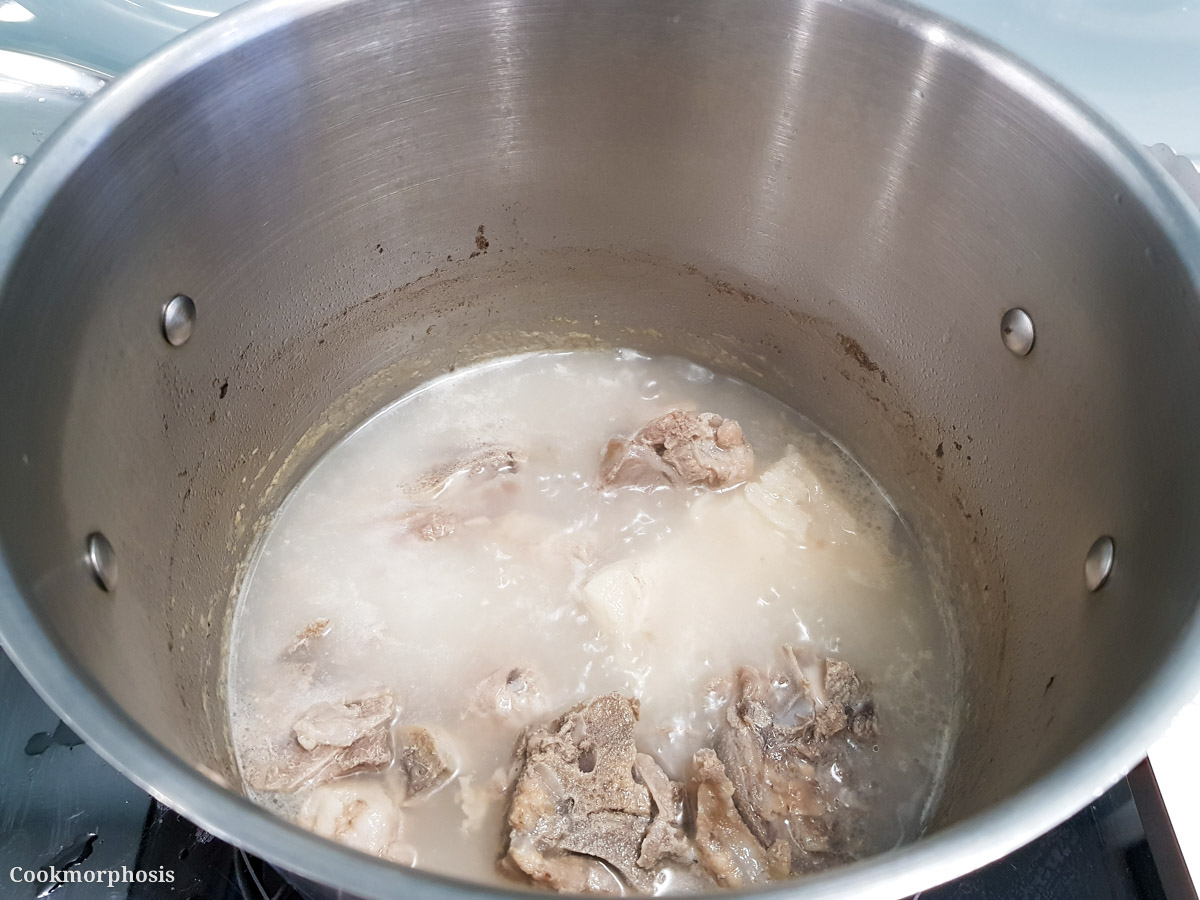
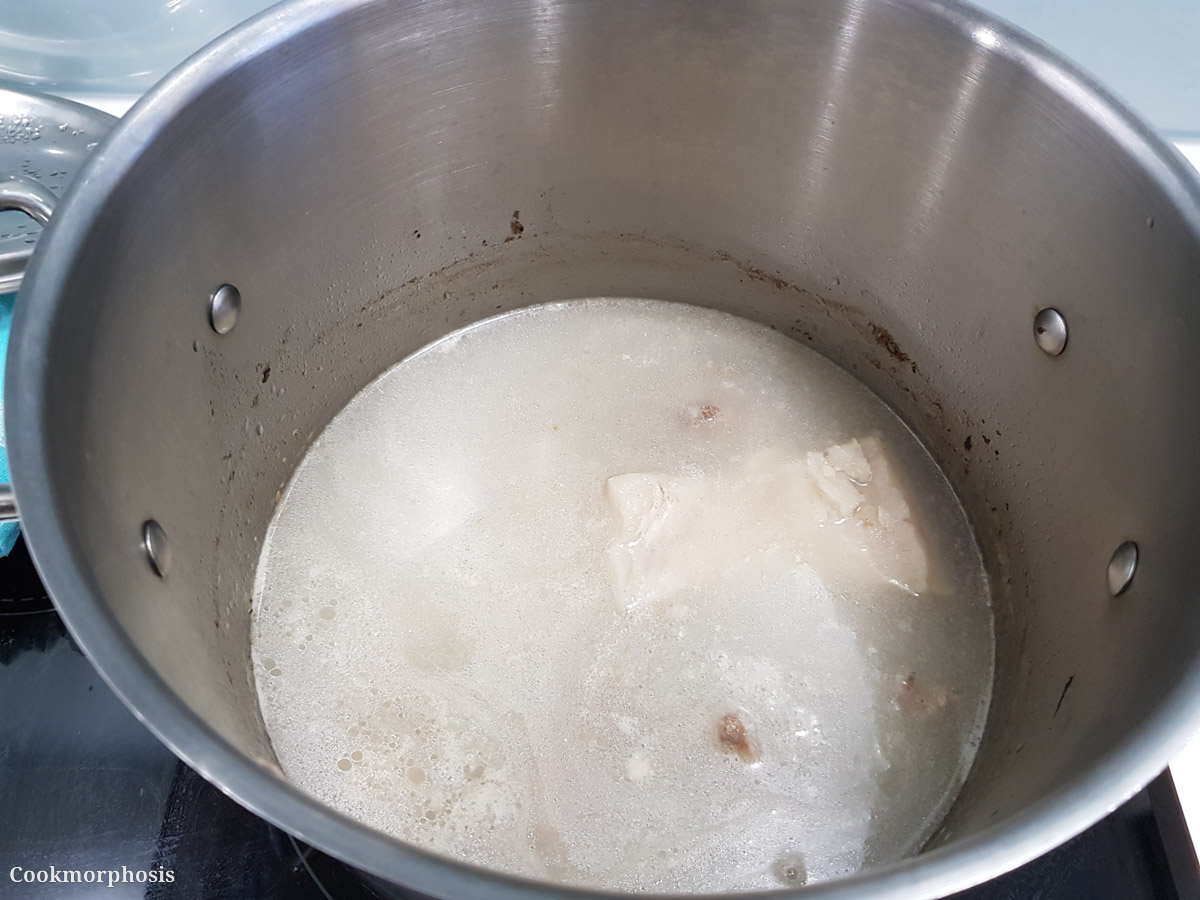
- When you can no longer get the soup milkier and creamier, turn off the heat. Strain the stock and set aside.
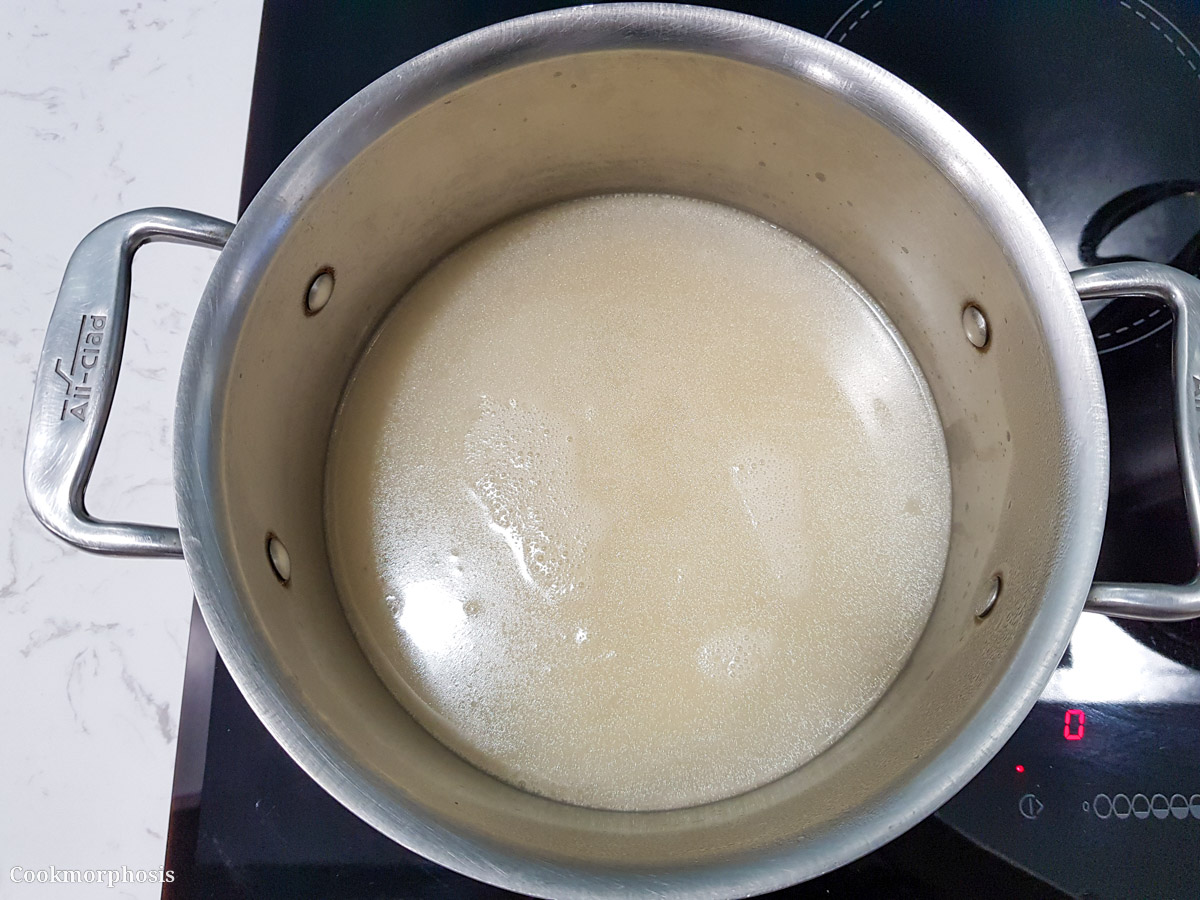
How to make chasu for tonkotsu ramen
Ingredients for chasu
- Pork belly, skin on
- Cooking sake
- Koikuchi shoyu - see details above
- Sweet mirin
- Light brown sugar
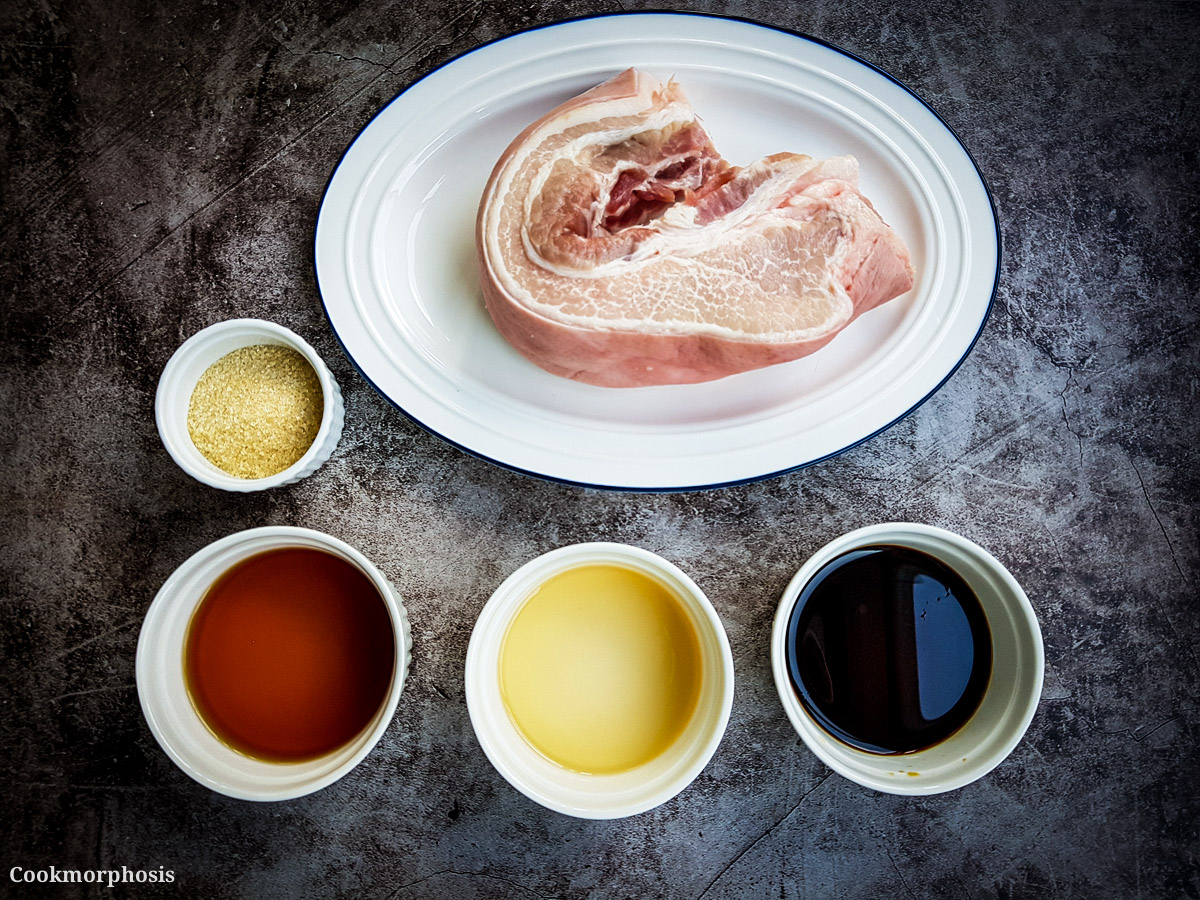
Process for making chasu (estimating time: 1.5 to 2 hours)
- Pat dry pork belly then lay it skin side down on a clean cutting board. Season lightly with salt and pepper.
- Neatly roll the meat into a roll then secure it tightly with cooking twine or butcher strings.
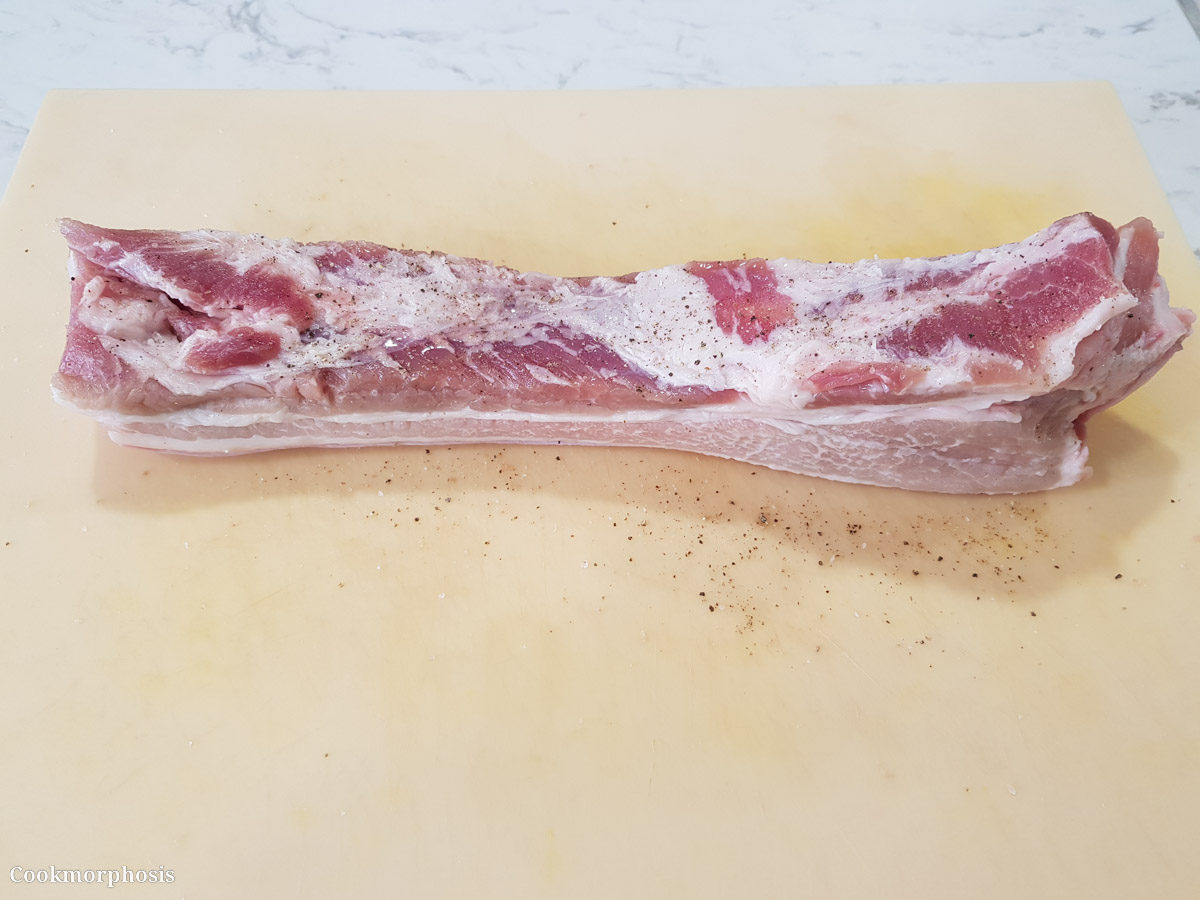
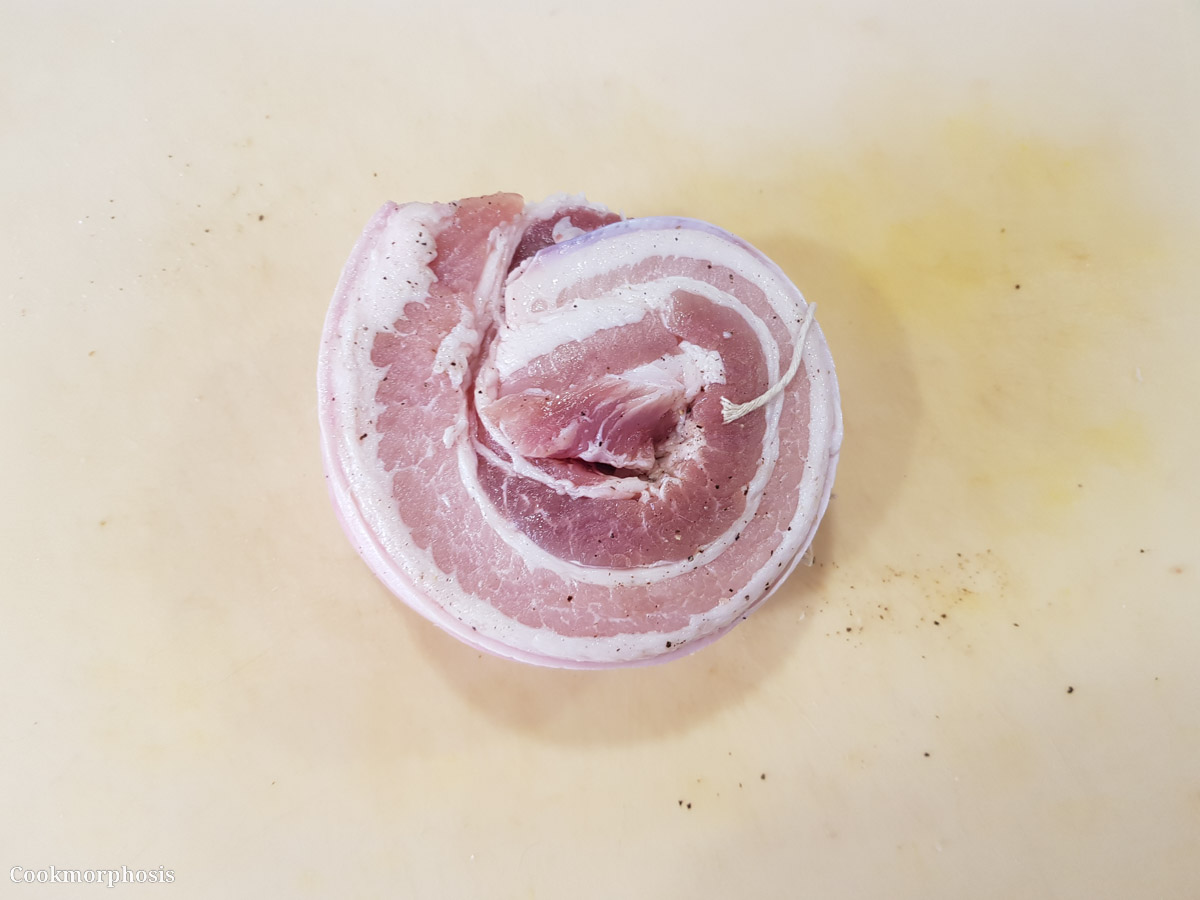
- In a medium cooking pot, add cooking sake and enough water to submerge roll of pork belly completely.
- Bring to boil then reduce the heat to medium-high and simmer until the liquid reduce more than half, approximately 30 to 40 minutes.
- Skim and discard any impurity floating to the surface

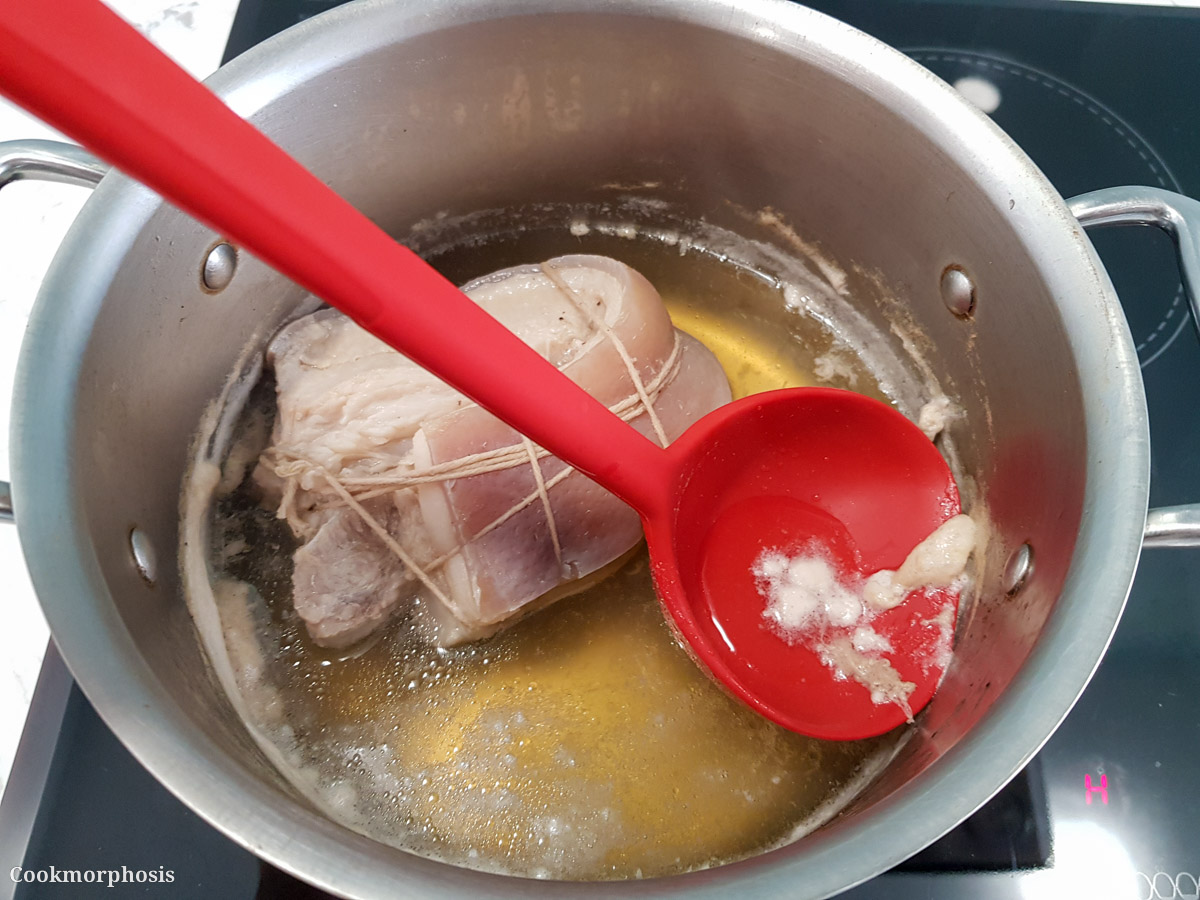
- Add mirin, brown sugar, and 2 soy sauce to the pot. Bring the pot back to boil until sugar dissolved completely.
- Remember to turn the heat occasionally so it can cook evenly in the sauce.
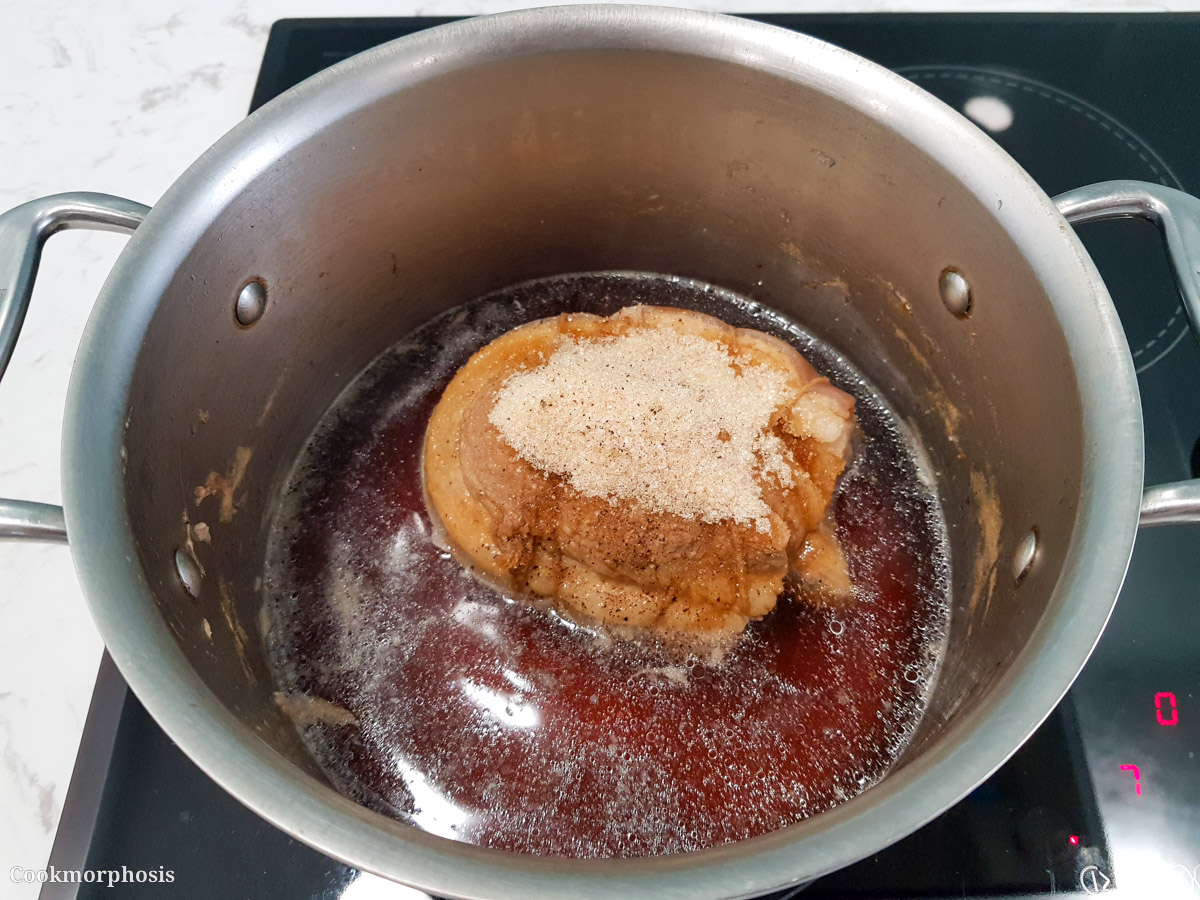
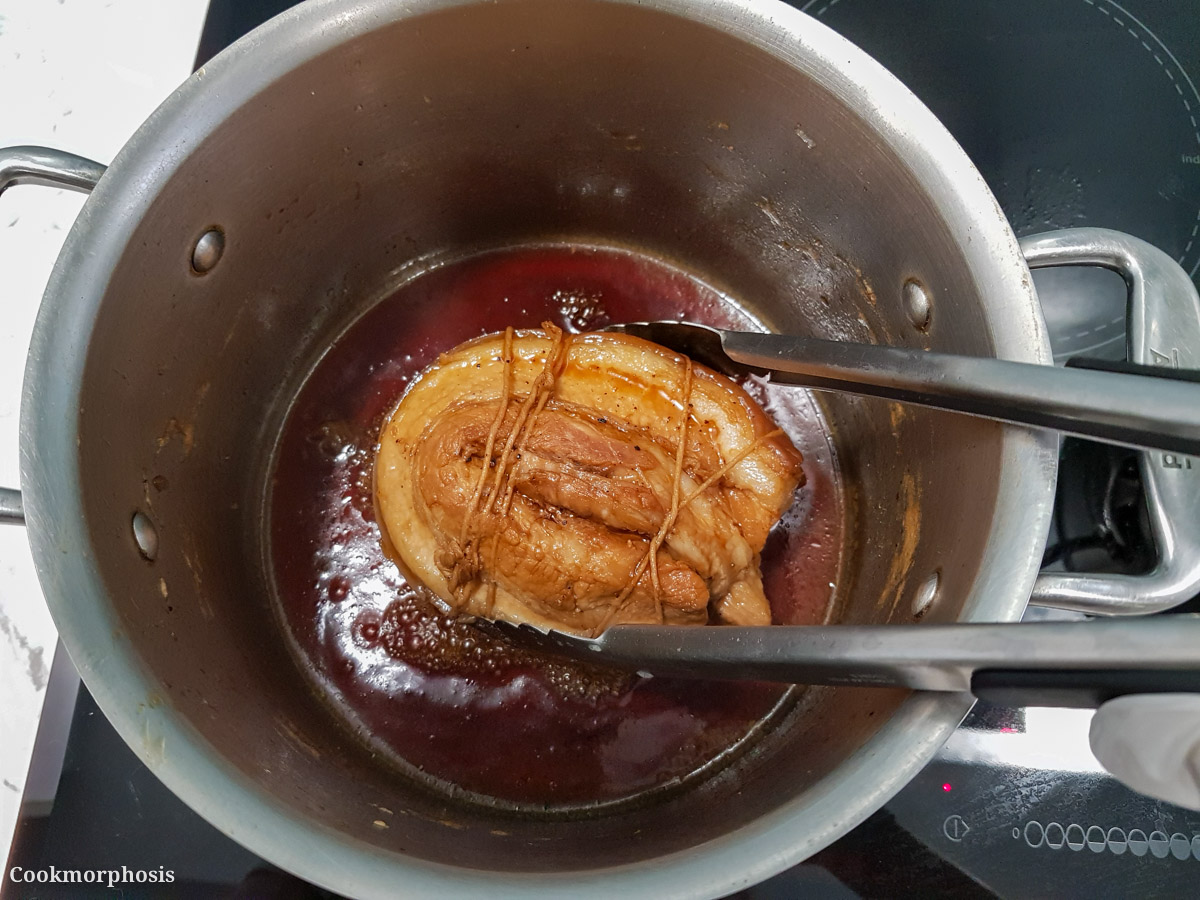
- You can partially cover the pot to speed up the process. Keep simmer the pot until the sauce reduce rapidly and start bubbling on the surface.
- When the sauce becomes caramelized and the pork belly looks shiny dark brown, the chasu is done.
- Turn off the heat. Take the pork belly out and cool down to room temperature before slicing into thin slices. Preserve the sauce for later use.


How to make seasoned bamboo shoots (menma)
Ingredients
- Unseasoned bamboo shoots
- Usukuchi shoyu - see details above
- Light brown sugar
- Kombu - see details above
Process
- Combine all ingredients in a pot, bring to boil then simmer for at least 45 minutes to an hour.
- When the bamboo shoots are tender, take them out of the liquid. Let them cool down at room temperature, cut into pieces, then set aside for later use. Serve cold.
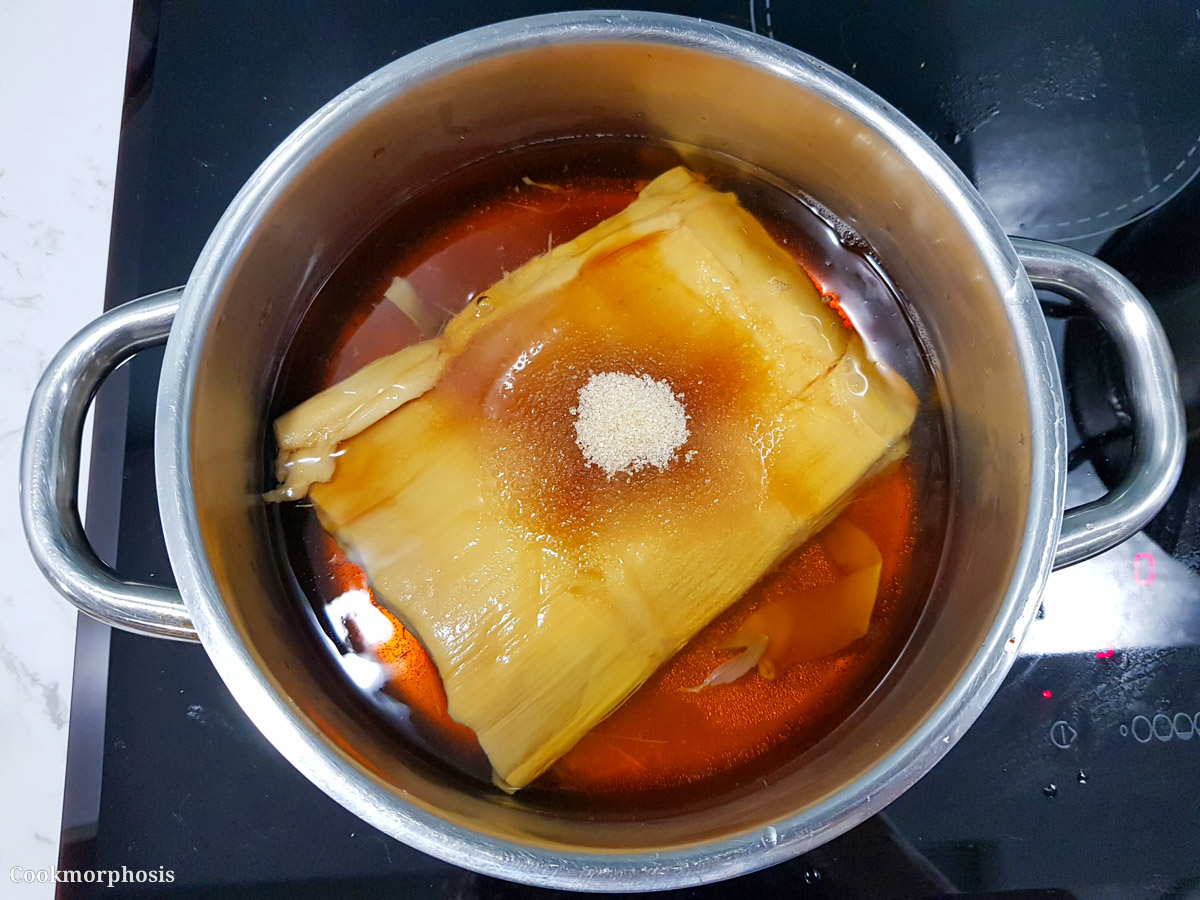
How to make spicy seasoned bean sprouts (Namuru)
Ingredients
- Bean sprouts
- Usukuchi shoyu
- Sesame oil
- Ichimi togarashi
Process
- Cook bean sprouts in boiling water for 2-3 minutes.
- Take them out and blanch in ice cold water immediately.
- Drain then add soy sauce, sesame oil, and chili pepper powder to season. Serve cold.

How to assemble tonkotsu ramen
- In a serving bowl, add about ¼ c ramen sauce.
- Followed by a desired amount of ramen noodle. Give a few stir to coat the noodle with the sauce completely.
- Add 1c of ramen stock in the bowl.
- Add chasu on top together with other desired topping.
- Quickly sear chasu in a cooking pan with a small amount of caramelized sauce before serving.

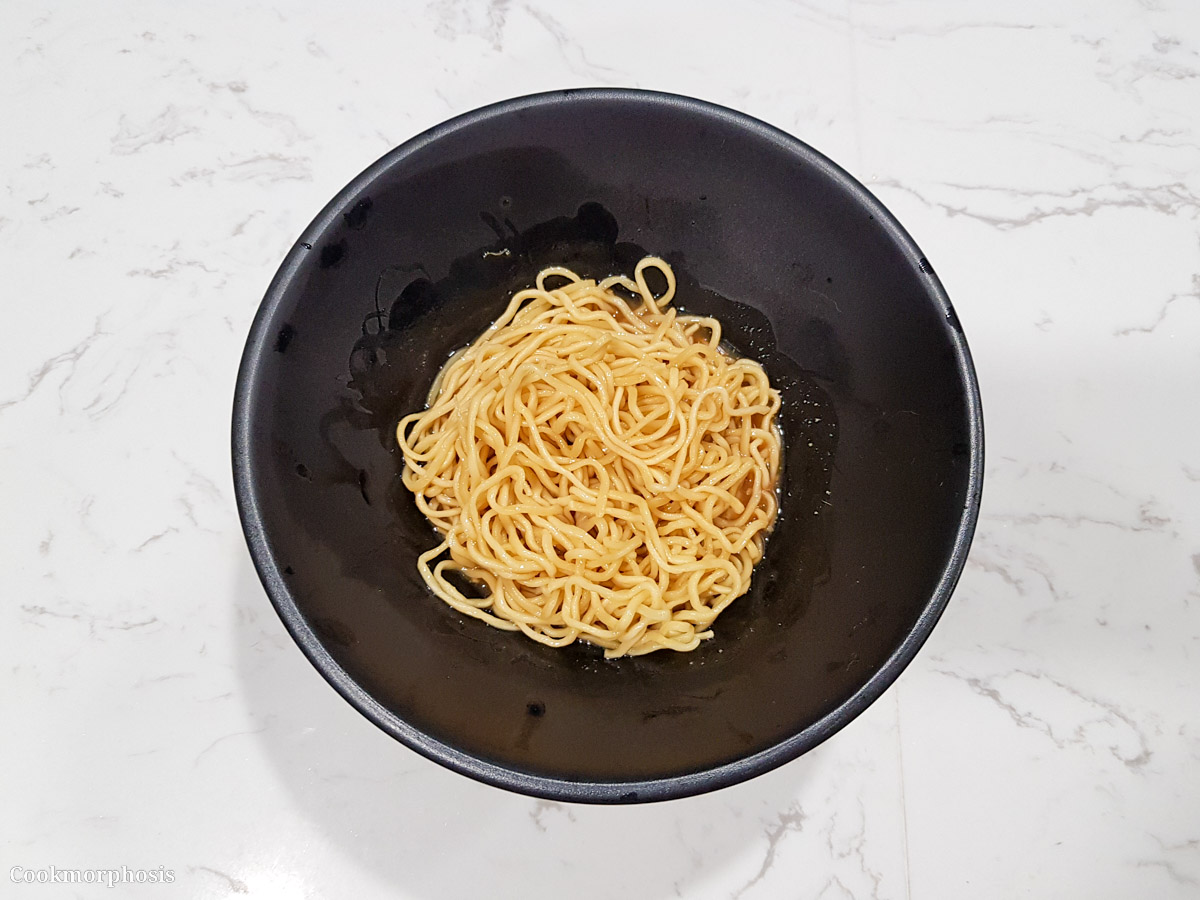
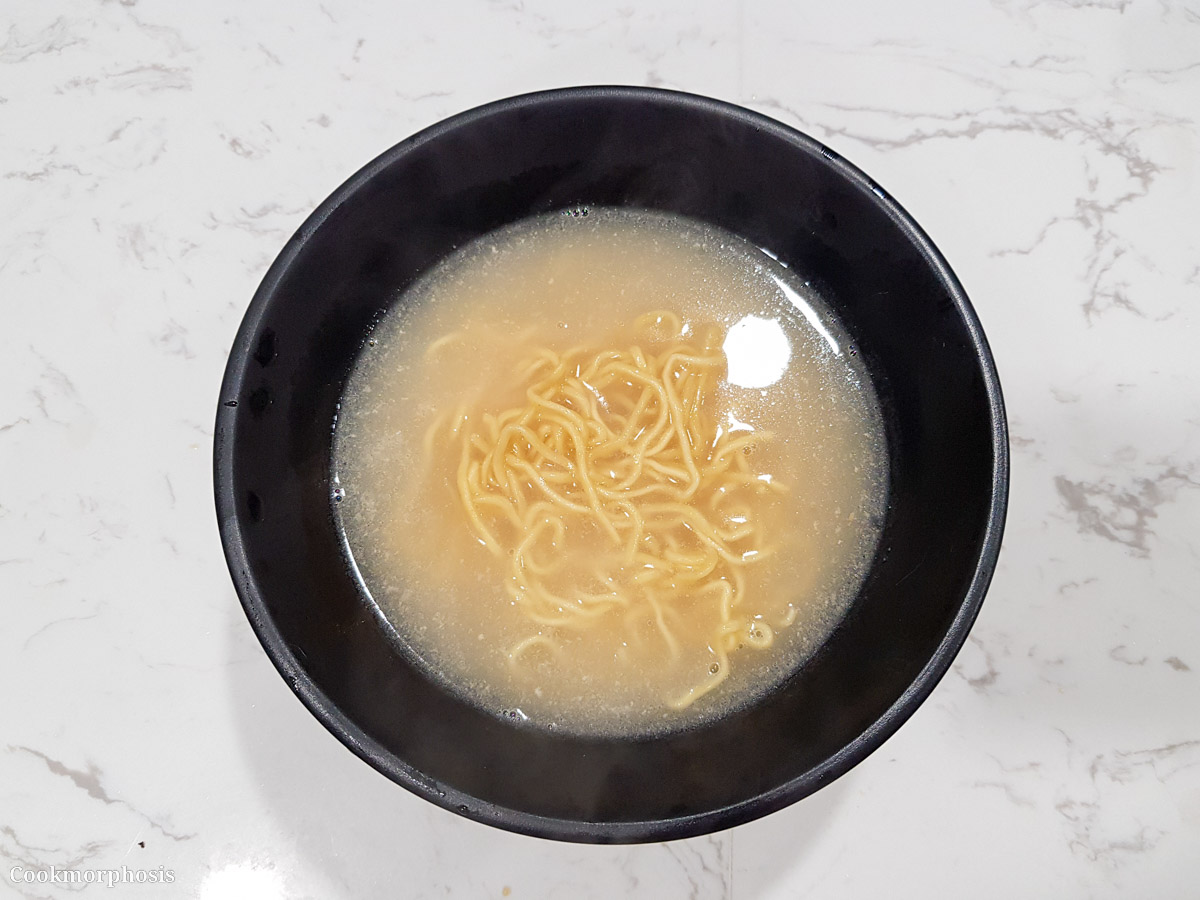
Notes: You can adjust the level of saltiness by add more or less ramen sauce and ramen stock.
BONUS
Here is the behind the scene I promised to share with you guys:
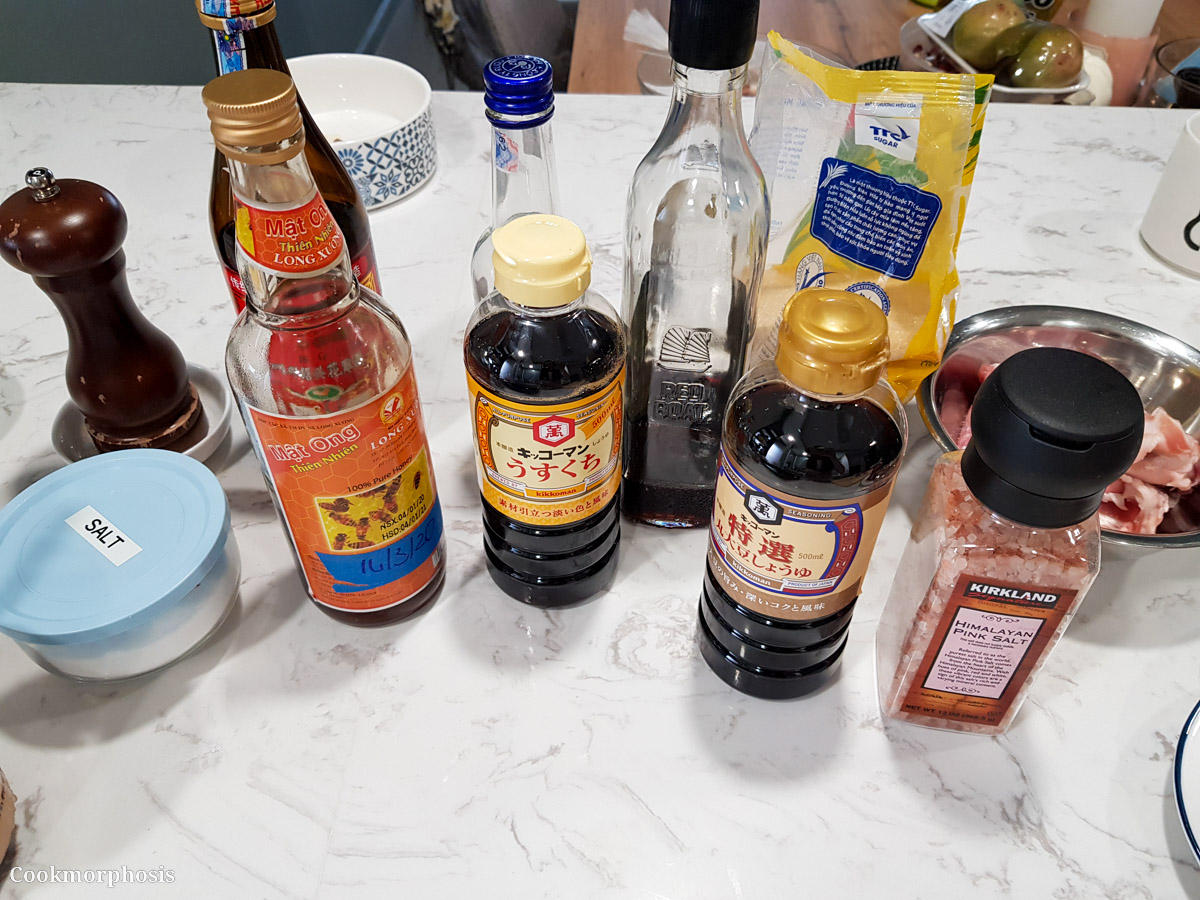
Congratulations! You are now certified to make the best Japanese tonkotsu ramen and homemade authentic ramen broth from scratch.
Well, by now you probably got the idea of how Japanese ramen is so expensive to buy. It takes a lot of work for the Chef to cook this amazing soup from zero to hero, doesn't it?
Related recipes
Other soup recipes that you might be interested in:
- Mexican chicken chili with kidney beans
- Vietnamese bun rieu cua (crab consommé soup)
- Vietnamese chicken pho
- Classic hot & sour shrimp soup (canh chua tom)
Did you make this recipe? If so please leave a rating and let me know how it went in the comment section. Also, don't forget to tag me #cookmorphosis @cookmorphosis on social media.
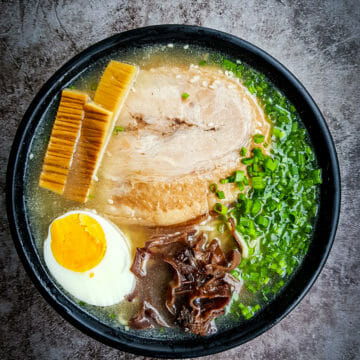
The best Japanese tonkotsu ramen from scratch
Ingredients
Ramen sauce
- 1 lb mussels fresh or frozen
- 3 c water
- ⅓ c usukuchi shoyu or light soy sauce
- 2 tbsp koikuchi shoyu or regular soy sauce
- ¼ c sweet mirin or light brown sugar
- 2 tbsp fish sauce or salt
- 2 tbsp cooking sake or Chinese cooking wine/vodka
- 2 tbsp apple cider vinegar
- 3 tbsp honey
- 2 pieces kombu
- 2 tbsp white miso or sake kasu
Ramen stock
- 1 lb pork bones
- 1 lb pork fat
Chasu
- 1 lb pork belly skin on
- 6 c water
- 1 c cooking sake
- ¼ c koikuchi shoyu
- 3 tbsp sweet mirin
- 2 tbsp light brown sugar
- salt and pepper to taste
Menma (seasoned bamboo shoot)
- 1 piece bamboo shoot uncut, unseasoned
- 2 c water
- ½ c usukuchi shoyu
- ¼ c light brown sugar
- 1 pc kombu
Namuru (spicy seasoned bean sprouts)
- 0.5 lb bean sprouts
- 4 c water
- 3 tbsp usukuchi shoyu
- 1 tsp sesame oil
- ichimi togarashi as needed
Other toppings
- wood ear fungus
- green onion
- white sesame seeds toasted
- ajitstuke tamago seasoned soft boiled egg
- dried seaweed
Instructions
For ramen sauce
- In a medium pot, combine water and mussels, bring to boil then simmer until the liquid reduce by half.1 lb mussels, 3 c water
- Strain through a fine mesh sieve. Discard the mussels.
- Return the liquid to the pot. Add the rest of the ingredients (except miso). Bring to boil again then reduce the heat to simmer.⅓ c usukuchi shoyu, 2 tbsp koikuchi shoyu, ¼ c sweet mirin, 2 tbsp fish sauce, 2 tbsp cooking sake, 2 tbsp apple cider vinegar, 3 tbsp honey, 2 pieces kombu
- Then add miso and cook until it dissolves completely.2 tbsp white miso
- Turn off the heat, remove the pot off the stove. Set it aside for later use.
- The ramen sauce is supposed to be salty than regular taste because it is used to season and adjust salty level of tonkotsu ramen.
For ramen stock
- Add pork bone into a large stocking pot and enough water to submerge them completely.1 lb pork bones
- Bring to boil then simmer the pot for at least an hour. Skin any impurity that is floating to the surface.
- After an hour, take out about 90% of the stock and set aside for later use.
- Then add pork fat and enough water to submerge everything completely, bring to boil again.1 lb pork fat
- Keep the pot boiling hard at all time on medium high heat to create such milky and cream texture for the soup.
- Cook the mixture for 2 hours. During the process, when the water reduces and no longer cover pork bones and fat, add more water immediately. Approximately 30 to 40 minutes between every cycle.
- After 2 hours has passed, continue cooking the stock for at least an hour. But this time, instead of adding fresh water to the pot, using 90% of stock was set aside to add to the pot.
- Repeat the process of adding more water when it is reduced below the bones. Approximately 20 to 30 minutes between each cycle.
- When you can no longer get the soup milkier and creamier, turn off the heat. Strain the stock and set aside.
For chasu
- Pat dry pork belly then lay it skin side down on a clean cutting board. Season lightly with salt and pepper.1 lb pork belly, salt and pepper
- Neatly roll the meat into a roll then secure it tightly with cooking twine or butcher strings.
- In a medium cooking pot, add cooking sake and enough water to submerge roll of pork belly completely.6 c water, 1 c cooking sake
- Bring to boil then reduce the heat to medium-high and simmer until the liquid reduce more than half, approximately 30 to 40 minutes.
- Skim and discard any impurity floating to the surface.
- Add mirin, brown sugar, and soy sauce to the pot. Bring the pot back to boil until sugar dissolved completely.¼ c koikuchi shoyu, 3 tbsp sweet mirin, 2 tbsp light brown sugar
- Remember to turn the heat occasionally so it can cook evenly in the sauce.
- You can partially cover the pot to speed up the process. Keep simmer the pot until the sauce reduce rapidly and start bubbling on the surface.
- When the sauce becomes caramelized and the pork belly looks shiny dark brown, the chasu is done.
- Turn off the heat. Take the pork belly out and cool down to room temperature before slicing into thin slices. Preserve the sauce for later use.
For menma
- Combine all ingredients in a pot, bring to boil then simmer for at least 45 minutes to an hour.1 piece bamboo shoot, 2 c water, ½ c usukuchi shoyu, ¼ c light brown sugar, 1 pc kombu
- When the bamboo shoots are tender, take them out of the liquid. Let them cool down at room temperature, cut into pieces, then set aside for later use. Serve cold.
For namuru
- Cook bean sprouts in boiling water for 2-3 minutes.0.5 lb bean sprouts, 4 c water
- Take them out and blanch in ice cold water immediately.
- Drain then add soy sauce, sesame oil, and chili pepper powder to season. Serve cold.3 tbsp usukuchi shoyu, 1 tsp sesame oil, ichimi togarashi
Assemble
- Quickly sear chasu in a cooking pan with a small amount of caramelized sauce before serving.
- In a serving bowl, add about ¼ c ramen sauce.
- Followed by a desired amount of ramen noodles. Give a few stir to coat the noodle with the sauce completely.
- Add 1.5c of ramen stock in the bowl.
- Add chasu on top together with other desired topping. Enjoy!wood ear fungus, green onion, white sesame seeds, ajitstuke tamago, dried seaweed
Did you make this recipe? If so please leave a rating and let me know how it went in the comment section. Also, don't forget to tag me #cookmorphosis @cookmorphosis on social media.

I used the recipe and it worked out pretty well. Love how details you provided with the instructions which guide me through the process flawlessly.
Hi Joeann,
Thank you so much for trying out the recipe. I'm so glad that the detailed step-by-step instructions worked out perfectly for you. It's a lot of works but totally worth the time, isn't it?